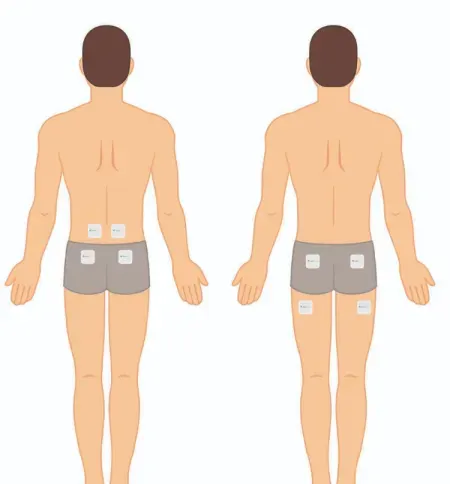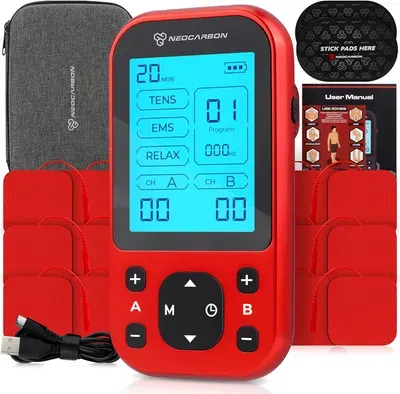Effective TENS Placement Techniques for Sciatica Relief You Need to Know
Table of Contents
- What Is TENS Therapy?
- How TENS Helps with Sciatica
- Identifying Sciatica Pain Points
- Recommended TENS Pad Placements
- Tips for Effective TENS Use
- Safety Precautions and Warnings
- Common TENS Mistakes to Avoid
- Combining TENS with Other Treatments
- When to Consult a Doctor
- Final Thoughts on Using TENS for Sciatica
Did you know that nearly 40% of adults will experience sciatica at some point? Understanding the proper placement of TENS (Transcutaneous Electrical Nerve Stimulation) units can be a game-changer for managing this painful condition.
In this article, we’ll delve into the specifics of TENS placement for sciatica relief, empowering you with practical knowledge to alleviate discomfort and improve your quality of life.
By the end, you’ll have clear guidance on how to use TENS therapy for optimal results.
1. Understanding TENS for Sciatica Relief
What is TENS Therapy?
TENS stands for Transcutaneous Electrical Nerve Stimulation. It’s a method that uses low-voltage electrical pulses to stimulate nerves through the skin. These pulses are delivered using a small, portable device connected to adhesive pads placed on your body.
You control the intensity and duration. Most units are battery-powered and easy to use at home. Many people use them to manage chronic or acute pain without relying on medication.
TENS doesn’t treat the root cause of pain. Instead, it aims to interrupt pain signals before they reach the brain and helps your body release endorphins, natural pain relievers.
How TENS Helps with Sciatica Pain
Sciatica is caused by irritation or compression of the sciatic nerve. This nerve runs from your lower back, through your hips and buttocks, and down each leg.
When the sciatic nerve is irritated, it sends pain signals along this path. TENS helps by:
- Blocking or reducing those pain signals
- Relaxing tense muscles that put pressure on the nerve
- Encouraging better blood flow in the area
Many people with sciatica feel temporary relief after just one session. With consistent use, TENS can become a useful part of your pain management plan.
2. Identifying Pain Points for Placement
TENS placement only works if you target the right spots. With sciatica, the pain can travel. It might start in your lower back and shoot down your leg. That’s because the sciatic nerve is the largest in your body, and it branches from the spine into the buttocks, thighs, and legs.
Common Sciatica Pain Zones:
- Lower back: The pain often begins near the lumbar spine.
- Buttocks: Pressure or tight muscles in the glutes can irritate the nerve.
- Back of the thigh: You may feel burning or aching along the hamstring.
- Calf and foot: In severe cases, pain or numbness reaches the lower leg or sole.
You might feel:
- Sharp or stabbing sensations
- Burning or tingling
- Numbness in one leg
- Pain when sitting or standing for long periods
Know the Source, Not Just the Symptoms
It’s tempting to place TENS pads where the pain feels strongest. But that’s not always the most effective strategy. Sciatica pain often travels. The real issue may be in your lower back, even if your foot hurts.
To get better results:
- Think about where the pain starts.
- Follow the path the pain travels.
- Target muscle areas around the nerve, not bone or joints.
Using this approach helps you place the pads where they’ll do the most good.
3. Recommended TENS Placement Techniques
You need to position TENS pads correctly to get relief. The goal is to surround the pain, not cover it, and stimulate the muscles around the sciatic nerve.
Basic Guidelines
- Use two or four pads, depending on the pain’s size and location.
- Keep pads at least one inch apart.
- Never place pads directly over your spine or any bony area.
- Stick to the muscle zones near the nerve.
Pad Placement Options for Sciatica:
Lower Back Placement
- Place two pads on each side of your lower spine, just above the buttocks.
- Don’t let the pads touch the spine directly.
- Best when the pain starts from the lumbar area.
Glutes (Buttocks)
- Place pads on the upper outer glutes, on either side of the most tender point.
- Targeting the piriformis muscle here can reduce nerve pressure.
- Good for deep aching or pressure in one buttock.
Hamstring (Back of Thigh)
- Place one pad at the top of the back of your thigh, and one midway down.
- This works well if pain travels down your leg.
Calf or Lower Leg
- Use one pad behind the knee and another on the upper calf.
- Try this if the pain goes past your knee or causes tingling in your foot.
You can test different pad setups to see what feels best. Everyone’s pain pattern is slightly different.
For visual learners, here’s a diagram showing the most effective pad placements along the sciatic nerve path:
👉 View Sciatica TENS Placement Diagram
You can follow this layout as a starting point and adjust based on your pain patterns.
4. Tips for Optimal TENS Usage
TENS can be effective, but only if you use it properly. Here’s how to get the most out of every session:
- Clean your skin first. Remove any lotion or sweat so the pads stick well.
- Start low. Begin with the lowest intensity and increase slowly until you feel a strong but comfortable sensation.
- Use for 20 to 30 minutes. That’s enough time to calm the nerves and relax the muscles.
- Limit to 2–3 sessions a day. More isn’t better. Give your body time between sessions.
- Replace pads when they lose stickiness. Poor contact reduces effectiveness.
Combine TENS with Other Strategies:
- Do gentle stretches after using TENS.
- Try heat or ice before or after a session.
- Take short walks to keep your muscles active.
Keep a pain journal. Record pad placement, intensity level, and how you felt after. This helps you find the best setup for your body.
Want a complete guide to pad placement for different pain areas?
Download this full-colour atlas for step-by-step instructions:
📥 Download the TENS Electrode Placement Atlas (PDF)
5. Safety Precautions When Using TENS
TENS is safe for most people, but it’s not risk-free. Use caution and follow these rules:
Where Not to Place Pads:
- Over your spine
- On the front of your neck or chest
- On open wounds or irritated skin
- On numb or desensitized areas
Avoid TENS if You Have:
- A pacemaker or implanted medical device
- Metal implants in the area you want to treat
- A seizure disorder (without medical advice)
- A heart condition (unless cleared by your doctor)
Pregnant? Skip TENS unless your doctor approves it, especially in the first trimester.
Read the manual. Each device is a bit different. Follow the guidelines for pad placement, intensity, and session time.
🎥 Watch: How to Use a TENS Unit for Lower Back and Sciatic Pain
This short video walks you through the correct placement and use:
6. Common Mistakes to Avoid
Using TENS wrong won’t just waste your time; it might make things worse. Watch for these common errors:
- Placing pads too close together. You need space between pads for the current to flow properly.
- Covering the spine directly. This can irritate the area instead of helping it.
- Turning intensity too high. Stronger isn’t always better. You want a firm but comfortable buzz.
- Using worn-out pads. Old or dry pads won’t work well.
- Only treating where it hurts. If you skip the source (often the lower back), relief may not last.
Avoid treating TENS like a magic fix. It’s a helpful tool, not a cure. Use it alongside stretching, posture changes, and movement.
7. Finding Relief with TENS Therapy
TENS therapy can give you more control over your sciatica pain. When used correctly, it offers short-term relief without medication.
The key is smart placement and consistent use. Know where your pain comes from, not just where it ends up. Test different pad setups and take notes. Combine TENS with other strategies like light movement and targeted stretches.
If you feel no change after several sessions, or if the pain gets worse, talk to a medical professional. You might need a different approach or diagnosis.
But for many, TENS is a practical, drug-free way to ease the daily sting of sciatica. It doesn’t fix everything—but it helps you move, rest, and focus with less discomfort.
Conclusion
The strategic placement of TENS (Transcutaneous Electrical Nerve Stimulation) units can significantly enhance the relief of sciatica pain.
By targeting specific areas along the sciatic nerve, individuals may experience a reduction in discomfort and an improvement in mobility.
It is essential to follow recommended guidelines for TENS placement to maximize effectiveness and ensure safety.
Additionally, incorporating TENS therapy with other treatment modalities, such as physical therapy and lifestyle modifications, can lead to more comprehensive management of sciatica symptoms.
If you're struggling with sciatica pain, consider exploring TENS therapy as a viable option to improve your quality of life.
People Also Asked
Q1: Where should I place TENS pads for sciatica?
A: Place them near the pain origin lower back, buttocks, or back of the thigh. Avoid placing them directly on the spine.
Q2: Does TENS therapy work for sciatica?
A: Yes, it can help block pain signals and improve blood flow. Many users report short-term relief.
Q3: How long should I use a TENS unit for sciatica?
A: Use it for 20–30 minutes per session, up to 2–3 times a day.
Q4: Can I use TENS therapy every day?
A: Yes, but avoid overuse. Space sessions out and rest between treatments.
Q5: Is TENS safe for everyone?
A: Most people can use it safely, but avoid it if you have a pacemaker, are pregnant, or have heart issues without a doctor’s OK.
Q6: What intensity should I set on my TENS unit?
A: Start low and increase until you feel a strong but comfortable buzz—never painful.
Q7: Can I place TENS pads on my spine?
A: No, always avoid direct placement on the spine or any bony areas.
Q8: How do I know if TENS is working?
A: You should feel less pain during or after the session. Keep a journal to track patterns.
Q9: Should I combine TENS with other therapies?
A: Yes. Stretching, heat therapy, and posture work well alongside TENS.
Q10: What’s the best TENS unit for sciatica?
A: Look for one with adjustable intensity, multiple modes, and good reviews for back pain relief.



